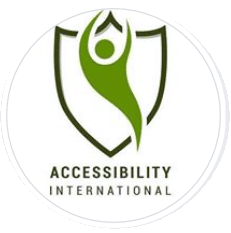What is Web Accessibility, and Why Does it Matter?
It’s hard to imagine life without the internet. Today with the click of a mouse all of the world’s knowledge is available to everyone. But what happens if you can’t use a mouse, see the screen, hear the audio, or even use a keyboard? What if the internet was not Accessible to you?
If you don’t have a disability it’s difficult to understand the challenges many people face doing something most of us take for granted. I hope the following article will help you understand the frustrations that people with disabilities experience when they are unable to enjoy all that the internet has to offer.
Hopefully everyone will embrace Universal Design principles and build web sites that are accessible to all.
What Does Web Accessibility Mean to the Disabled?
Most of us are familiar with how Accessibility applies to physical business places. However, little thought has been given to how Accessibility applies to the Internet. Accessibility on the World Wide Web demands that we break down barriers and open a clear path for everyone.
This means that web pages must be designed so that those with Visual, Hearing, Motor and Cognitive disabilities have an equal opportunity to navigate and access every web page.
The Web Offers Accessibility Opportunities
You may not have thought about it, but web accessibility is important for people with disabilities. To ensure Web Accessibility, it must be fully integrated into all of the websites people visit.
Before the internet, blind people did not have equal access to reading newspapers, magazines and books. Braille or audio versions were expensive and impractical, if they were available. The blind were dependent on others.
Today that is changing, as more web designers use Universal Design principles and the internet is opening up to those with disabilities.
The Web’s Visual Accessibility Opportunities
Today newspapers are available online and screen readers make reading materials of all types more accessible to the blind.
Screen readers are software programs which read text out loud so the blind can access any text content through their phone, tablet, laptop or desktop computer.
Technology has freed the blind from being dependent on others and given them freedom to access the text material they want if the site has been designed to meet WCAG 2.0 Guidelines. Today, the blind can open their browser and listen as their screen reader, reads the chosen text for them.
The Web’s Physical Accessibility Opportunities
For those with physical or motor disabilities and unable to perform the motor tasks that most of us take for granted. Today assistive technology can adapt computer to help them overcome their disabilities. These adaptations may be as simple as a person using a stylus in their mouth to type on their keyboard.
Physical adaptations for the disabled can also be more sophisticated with special keyboards or eye-tracking devices and software allowing people to control their computer with eye movements.
Using Assistive Technology the deaf can read online transcripts or captions of online content. Others with Cognitive Disabilities may benefit from the webs structure and flexibility in organizing content.
Falling Short of the Web’s Potential
Despite it’s potential, web accessibility for the disabled is largely unfulfilled. Under the guidance of the Web Accessibility Initiative (WAI), efforts to improve the accessibility of the World Wide Web (WWW or Web) for people with disabilities are improving daily.
Many sites still can only be navigated using a mouse, and most multimedia content has not been captioned for the deaf. If graphics are used in place of text, it is even worse.
Screen readers are unable to read the graphics to people who are blind. People with disabilities may encounter difficulties when using computers generally, but those difficulties are compounded when they attempt to use the internet.
Since people with disabilities often require non-standard devices and browsers, making websites more accessible also benefits a wide range of user agents and devices, including mobile devices, which have limited resources.

The parable of the blind men and an elephant originated in the ancient Indian subcontinent, from where it has been widely diffused. It is a story of a group of blind men, who have never come across an elephant before and who learn and conceptualize what the elephant is like by touching it.
Each blind man feels a different part of the elephant’s body, but only one part, such as the side or the tusk. They then describe the elephant based on their limited experience and their descriptions of the elephant are different from each other.
Web Accessibility is the attempt to give everyone the same subjective experience when they visit the same web page.
People with Disabilities on the Web
Studies estimate that up to 20% of the population has a disability that makes it difficult for them to access the internet. It is smart for businesses to do everything they can to serve everyone and not exclude those with disabilities from their sites. Plus it’s illegal under current law to not provide equal access for the disabled.
Let’s examine the major categories of disability which we have to serve and how we can accomplish compliance with the law. The disabilities we have to deal with are: Visual, for those dealing with blindness, low vision and color-blindness; Hearing, for deafness and hard of hearing; Physical or Motor, involving the inability to use a mouse, slow response times, or limited motor control; Cognitive, involving learning disabilities, inability to remember or focus on information.
Disabilities Require Different Web Design Adaptations
Each type of disability requires different adaptations in web design and how content is presented. Many times new adaptations benefit everyone, not just the disabled.
Everyone benefits from helpful illustrations, organized content and clear navigation. Captions although a necessity for the deaf, can be helpful to others who view a video without audio.
To serve the needs of the deaf, audio games have been developed, they are an electronic game similar to a video game except there is audible and tactile feedback but not visual and played on a personal computer.
Understanding User Perspectives
Understanding user perspective gives a greater appreciation of the need for web accessibility. To help you understand watch this 11.5 minute video to view the difficulties the disabled face on the web and some motivations for embracing web accessibility.
Implementing Web Accessibility
Before you can make your web site accessible, you must understand web accessibility. You must also be committed to providing accessibility to others, learn how to implement accessibility, and understand your legal obligations.
The watchwords of web accessibility are commitment and accountability.
Commitment and Accountability
Awareness Your commitment to web accessibility must be anchored in an awareness of the issues. Developers are not opposed to accessibility for all. Accessibility problems on web sites are usually from an ignorance of the issues, not any malicious intent.
Leadership Understanding the issues is the beginning, but not the solution. Leaders need to express their commitment to web accessibility, without that commitment it is unlikely that the web content will be accessible. Developers may have to make their content accessible without instruction, simply because it’s the right thing to do.
Policies and Procedures Even after leaders commit to the idea of accessibility, the idea of accessibility needs to be supported by policies and daily routines. That’s why it’s important to create an internal policy policies that create standards, procedures and methods to monitor compliance.
Training and Technical Support
Web developers need to be supported in creating accessible web sites. It is easier and preferable to create a site that is accessible than to have to return and redo work already done. More customers able to access and navigate your site will make the effort worthwhile.
The basics of web accessibility do not require additional technical skills, however it does require a change of mindset as well as adopting the necessary techniques. Online Resources are available which provide relevant accessibility resources for administrators, developers, and designers.
Laws and Standards
In the United States, applicable laws pertaining to Web Accessibility include The Americans with Disabilities Act (ADA) and the Rehabilitation Act of 1973 (Sections 504 and Section 508). Many international laws also address the question of Web Accessibility.
Principles of Accessible Design
Below you will find a list of some key principles of accessible design. Most accessibility principles can be implemented very easily and will not impact the overall “look and feel” of your web site. It’s easy if you embrace and utilize these principles as you build your site
Provide AlternativeText
Alternative text provides a textual alternative to non-text content in web pages. It is especially helpful for people who are blind and rely on a screen reader to have the content of the website read to them.
Provide Document Structure
Headings, lists, and other structural elements provide meaning and a structure to your web pages that screen readers can easily follow. They can also facilitate keyboard navigation within the page.
Provide Headers for Data Tables
Tables are used online for layout and to organize data. Tables that organize tabular data should have appropriate table headers (use the <th> element). Data cells within tables should be associated with their appropriate headers.
Doing this will make it easier for screen reader users to navigate and understand the data table.
Ensure that Forms Work
Ensure that every form element (text field, checkbox, dropdown list, etc.) has a label. Ensure that each label is associated to the correct form element using the <label> element. Also make sure the user can submit the form and recover from any errors, such as the failure to fill in all required fields.
Caption and/or Provide Transcripts
Videos and live audio must have captions and a transcript. With archived audio, a transcription may be sufficient.
Ensure Accessibility of non-HTML Content
This includes PDF files, Microsoft Word documents, PowerPoint presentations and Adobe Flash content. In addition to all of the other principles listed here, PDF documents and other non-HTML content must be as accessible as possible.
If you cannot make it accessible, consider using HTML instead or, at the very least, provide an accessible alternative. PDF documents should also include a series of tags to make it more accessible. A tagged PDF file looks the same, but it is almost always more accessible to a person using a screen reader.
Allow Users to Skip Repetitive Elements
You should provide a method that allows users to skip navigation or other elements that repeat on every page. This is usually accomplished by providing a “Skip to Main Content,” or “Skip Navigation” link at the top of the page which jumps to the main content of the page.
Do Not Rely on Color Alone
The use of color can enhance comprehension, but do not use color alone to convey information. That information may not be available to a person who is colorblind and will be unavailable to screen reader users.
Use Clearly Written Content
There are many ways to make your content easier to understand. Write clearly, use clear fonts, and use headings and lists appropriately.
Make Javascript Accessible
Ensure that JavaScript event handlers are device independent (e.g., they do not require the use of a mouse) and make sure that your page does not rely on JavaScript to function.
Design to Standards
HTML compliant and accessible pages are more robust and provide better search engine optimization. Cascading Style Sheets (CSS) allow you to separate content from presentation. This provides more flexibility and accessibility of your content.
This list does not present all accessibility issues, but by addressing these basic principles, you will ensure greater accessibility of your web content to everyone.
Accessibility Success is a Great Conclusion
The web offers opportunities to the disabled which are unavailable in other medium, giving freedom and independence. If a web site is not web accessible, it excludes part of our population with the most to gain from the internet.
Most Don’t Mean to Exclude the Disabled
Most do not intend to exclude people with disabilities, however organizations and designers need to be aware of and implement accessibility. This will ensure that web content can be accessed by a broader population.



